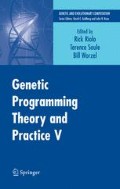Simple Genetic Programming (GP) is generally considered to lack the strong separation between genotype and phenotype found in natural evolution. In many cases, the genotype and the phenotype are considered identical in GP since the program representation does not undergo any modification prior to its encounter with “environment” in the form of inputs and a fitness function. However, this view overlooks a key fact: fitness in GP is determined without reference to the makeup of the individual programs but evolutionary changes occur in the structure and content of the individual without reference to its fitness. This creates a disconnect between “genetic recombination” and fitness similar to that in nature that can create unexpected effects during the evolution of a population and suggests an important dynamic that has not been thoroughly considered by the GP community. This paper describes some of the observed effects of this disconnect and studies some approaches for the estimating diversity of a population which could lead to a new way of modeling the dynamics of GP.We also speculate on the similarity of these effects and some recently studied aspects of natural evolution.
Access this chapter
Tax calculation will be finalised at checkout
Purchases are for personal use only
Preview
Unable to display preview. Download preview PDF.
References
Angeline, Peter J. 1997. Subtree crossover: Building block engine or macromutation? In Koza, John R., Deb, Kalyanmoy, Dorigo, Marco, Fogel, David B., Garzon, Max, Iba, Hitoshi, and Riolo, Rick L., editors, Genetic Programming 1997: Proceedings of the Second Annual Conference, pages 9-17, Stanford University, CA, USA. Morgan Kaufmann.
Daida, Jason M. (2003). What makes a problem GP-hard? A look at how structure affects content. In Riolo, Rick L. and Worzel, Bill, editors, Genetic Programming Theory and Practice, chapter 7, pages 99-118. Kluwer.
Darwin, C. 1859. On the Origin of Species by Means of Natural Selection or the Preservation of Favoured Racs in the Struggle for Life. Murray, London, UK.
Ek árt, Anik ó and N émeth, Sandor Zoltan 2002. Maintaining the diversity of genetic programs. In Foster, James A., Lutton, Evelyne, Miller, Julian, Ryan, Conor, and Tettamanzi, Andrea G. B., editors, Genetic Programming, Proceedings of the 5th European Conference, EuroGP 2002, volume 2278 of LNCS, pages 162-171, Kinsale, Ireland. Springer-Verlag.
Fontana, W. (2003). The topology of the possible. Working paper 03-03-017, The Santa Fe Institute, Santa Fe.
Huber, S.K. (2006). Premating isolation of sympatric morphs in a population of drawin’s finches (geospiza fortis). In Animal Behavior Society 43rd Annual Meeting, Snowbird, Utah.
Iwashita, Makoto and Iba, Hitoshi (2002). Island model GP with immigrants aging and depth-dependent crossover. In Fogel, David B., El-Sharkawi, Mohamed A., Yao, Xin, Greenwood, Garry, Iba, Hitoshi, Marrow, Paul, and Shackleton, Mark, editors, Proceedings of the 2002 Congress on Evolutionary Computation CEC2002, pages 267-272. IEEE Press.
Jeffrey, H.J. 1990. Choas game representation of gene structure. Nucleic Acids Res, 18(8):2163-70.
Kirschner, Marc W. and Gerhart, John C. (2005). The Plausibility of Life: Resolving Darwin’s Dilemma. Yale University Press.
Koza, John R. 1992. Genetic Programming: On the Programming of Computers by Means of Natural Selection. MIT Press, Cambridge, MA, USA.
MacArthur, R. and Wilson, E.O. (1967). The Theory of Island Biogeography. Princeton University Press.
Poli, Riccardo and Langdon, W. B. 1997. An experimental analysis of schema creation, propagation and disruption in genetic programming. In Back, Thomas, editor, Genetic Algorithms: Proceedings of the Seventh International Conference, pages 18-25, Michigan State University, East Lansing, MI, USA. Morgan Kaufmann.
Rosca, Justinian P. 1995. Entropy-driven adaptive representation. In Rosca, Justinian P., editor, Proceedings of the Workshop on Genetic Programming: From Theory to Real-World Applications, pages 23-32, Tahoe City, California, USA.
Ryan, Conor, Majeed, Hammad, and Azad, Atif 2004. A competitive building block hypothesis. In Deb, Kalyanmoy, Poli, Riccardo, Banzhaf, Wolfgang, Beyer, Hans-Georg, Burke, Edmund, Darwen, Paul, Dasgupta, Dipankar, Floreano, Dario, Foster, James, Harman, Mark, Holland, Owen, Lanzi, Pier Luca, Spector, Lee, Tettamanzi, Andrea, Thierens, Dirk, and Tyrrell, Andy, editors, Genetic and Evolutionary Computation - GECCO2004, Part II, volume 3103 of Lecture Notes in Computer Science, pages 654-665, Seattle, WA, USA. Springer-Verlag.
Spector, Lee and Klein, Jon 2005. Trivial geography in genetic programming. In Yu, Tina, Riolo, Rick L., and Worzel, Bill, editors, Genetic Programming Theory and Practice III, volume 9 of Genetic Programming, chapter 8, pages 109-123. Springer, Ann Arbor.
Wicker, Thomas, Schlagenhauf, Edith, Graner, Andreas, Close, Timothy, Keller, Beat, and Stein, Nils (2006). Published online.
Yu, Tina and Bentley, Peter (1998). Methods to evolve legal phenotypes. In Eiben, Agoston E., Back, Thomas, Schoenauer, Marc, and Schwefel, HansPaul, editors, Fifth International Conference on Parallel Problem Solving from Nature, volume 1498 of LNCS, pages 280-291, Amsterdam. SpringerVerlag.
Author information
Authors and Affiliations
Editor information
Editors and Affiliations
Rights and permissions
Copyright information
© 2008 Springer Science+Business Media, LLC
About this chapter
Cite this chapter
Almal, A.A., MacLean, C.D., Worzel, W.P. (2008). Programstructure-Fitnessdisconnect and Its Impact on Evolution in Genetic Programming. In: Riolo, R., Soule, T., Worzel, B. (eds) Genetic Programming Theory and Practice V. Genetic and Evolutionary Computation Series. Springer, Boston, MA. https://doi.org/10.1007/978-0-387-76308-8_9
Download citation
DOI: https://doi.org/10.1007/978-0-387-76308-8_9
Publisher Name: Springer, Boston, MA
Print ISBN: 978-0-387-76307-1
Online ISBN: 978-0-387-76308-8
eBook Packages: Computer ScienceComputer Science (R0)

